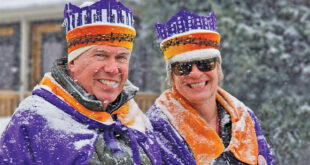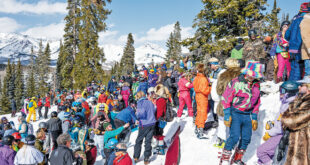Wayne Wong is a ski icon.
In 1966, age 16, he was a certified Canadian Ski Instructor. By 1972, he was a fully certified ski instructor while he and a host of other skiers on the fringe of the industry were opening the eyes of the world to freestyle skiing, also know as hotdoggin’.
For you young kids, Wayne Wong had the same effect on the skiing culture in the ’70s that Shane McConkey had in the ’90s. Ironically, both were born in Vancouver, British Columbia.
And now at age 62 with over 50 years on skis, he’s still at it getting anywhere from 60 to 90 days on snow every year. And he still takes time out to meet and greet with anyone, always remembers their name and takes it all in stride with his trademark grin and white sunglasses.
Wong reflects fondly on the heyday of hotdoggin’ as the best of times. He entered his first exhibition skiing competition in 1971 in Waterville Valley, N.H., which just happened to be the first national championships of exhibition skiing. Exhibition skiing consisted of three disciplines—aerials, moguls and ski ballet.
“There was a discussion about who was the best skier and it sounded like a pretty cool idea,” recalls Wong. “I had a whole bag of tricks up my sleeve that no one had seen.”
Wong ended up taking third place and $1,000 in cash.
“I was happy as a clam,” he adds. “That was the start of my career.”
Wong settled in Waterville Valley to become a freestyle coach, earning $125 a week for seven days of work and remained on the exhibition competition tour.
In 1972, the tour consisted of three stops in Waterville Valley, Sun Valley and Vail. Wong went on to win the overall crown and was named the 1972 Hotdogger of the Year.
The competition scene ramped up and the scene remained as loose.
“’72-’73 was really fly by your pants,” says Wong. “It was undisciplined but it was a blast. The atmosphere was so alive, new and exciting.”
And being the ’70s, undisciplined and exciting there was the party as well and Wong admits that everywhere they went to compete, there was their fair share of after-parties.
As the competition scene got more and more interest from sponsors and there was a push to organize the events, the freedom soon dissipated.
“Some took training somewhat serious. I just skied every day,” explains Wong. “I just loved what I was doing. I loved going out and skiing. It lost the original concept of the freedom of it.”
Wong left the freestyle scene on top, having won championship events in Japan, Europe and the U.S. in 1976.
He went through some darker times, taking on more administrative roles in the world of skiing including running a ski school until a friend pulled him aside and told him, “Wayne, you gotta get back on the ski hill.”
That led him into charity ski events, which landed Wong in Crested Butte in the mid-1980s. With his competition hotdogging days and administrative ski school days behind him, he came to Crested Butte as part of a celebrity ski week to raise money for cystic fibrosis.
“That’s when I realized my calling in life,” says Wong. “The light bulb came on when I was here. I realized I could help these kids.”
Since then, Wong, in partnership with American Airlines and at times BMI and Country in the Rockies, has helped raise $26 million for cystic fibrosis.
While maintaining his commitment to fundraising, Wong has developed a side project: suspension skis. He got hooked up with an engineer and they have developed a suspension ski called Anton Skis. They have to be skied to be believed, insists Wong. Just as shaped skis transformed the ski industry years ago, Wong feels suspension skis will do the same.
“Our skis now like to grip and rip,” says Wong. “I’m a G Force junkie. If I was given a choice between a foot of fresh powder and hard corduroy, I’d take hard corduroy.”
Though after further thought, he adds, “Don’t get me wrong, I love skiing powder.”
In fact the best day of skiing of his 52 years on snow he ever had was heli-skiing in 10 to 12 inches of fresh in Canada.
“I was just taking in the views, glaciers to the west of me, late afternoon and I had a 5,000-foot run with no one around and I was laughing to myself thinking, this is surreal,” recalls Wong.
Other highlights include winning hotdogger of the year in 1972, a Pepsi commercial shoot and the people he has met along the way skiing for his charitable organization.
“I’ve been blessed to experience things a regular skier hasn’t been able to do,” says Wong. “I know there are better skiers than I am but I doubt they’ve had more fun than I have.”
Ironically, he touts his claim to fame as having an effect on the biking world—one biker and three-time Tour de France winner to be specific.
“In the ’70s we used to do these ski camps at Whistler in the summer and one kid asked me how I keep in shape over the summer,” explains Wong. “I told him I ride my ten-speed.”
Years later, that same summer ski camper, Greg LeMond, was stepping on top of the podium at the Tour de France as the first American to win the prestigious race. LeMond went on to credit Wong for his introduction to bike racing.
“That’s my real claim to fame, I think,” says Wong.
In between his charity ski functions, he also has his own clinics going with the tagline Learn Right from Wong, which brought him back to Crested Butte two weeks ago, an area he believes to have one of the strongest cores of skiers.
“Crested Butte’s niche is that it’s a real skier’s ski area,” says Wong. “You have a really serious core of backcountry skiers here and really great tele skiers here.”
In the end, Wong credits his longevity in skiing to one thing.
“Passion, straight passion,” says Wong. “I love the sport.”
Check Also
Cliques, parking, commuter trails, the haves and have nots
[ By Aimee Eaton ] With a flurry of snow and high winds the ski …
 The Crested Butte News Serving the Gunnison Valley since 1999
The Crested Butte News Serving the Gunnison Valley since 1999



